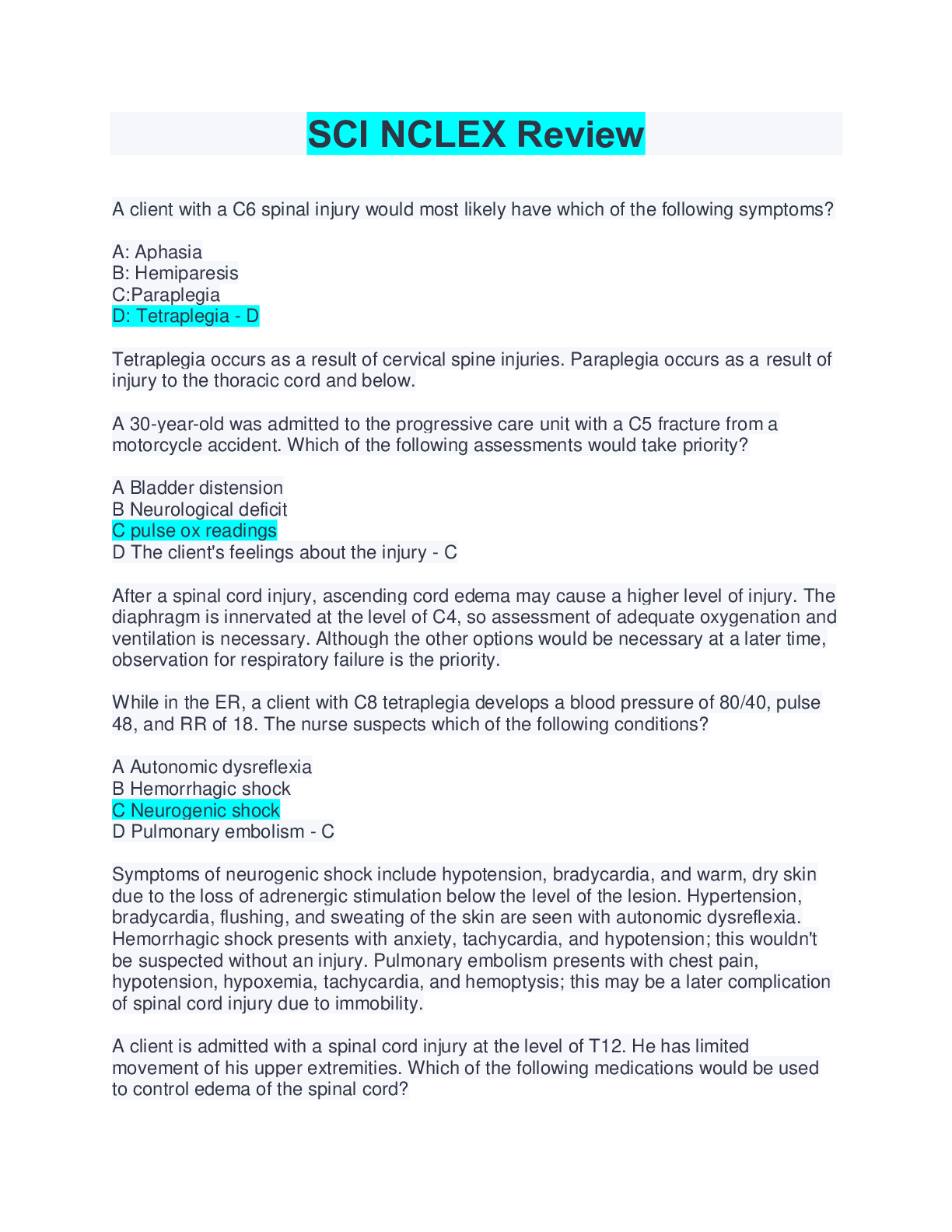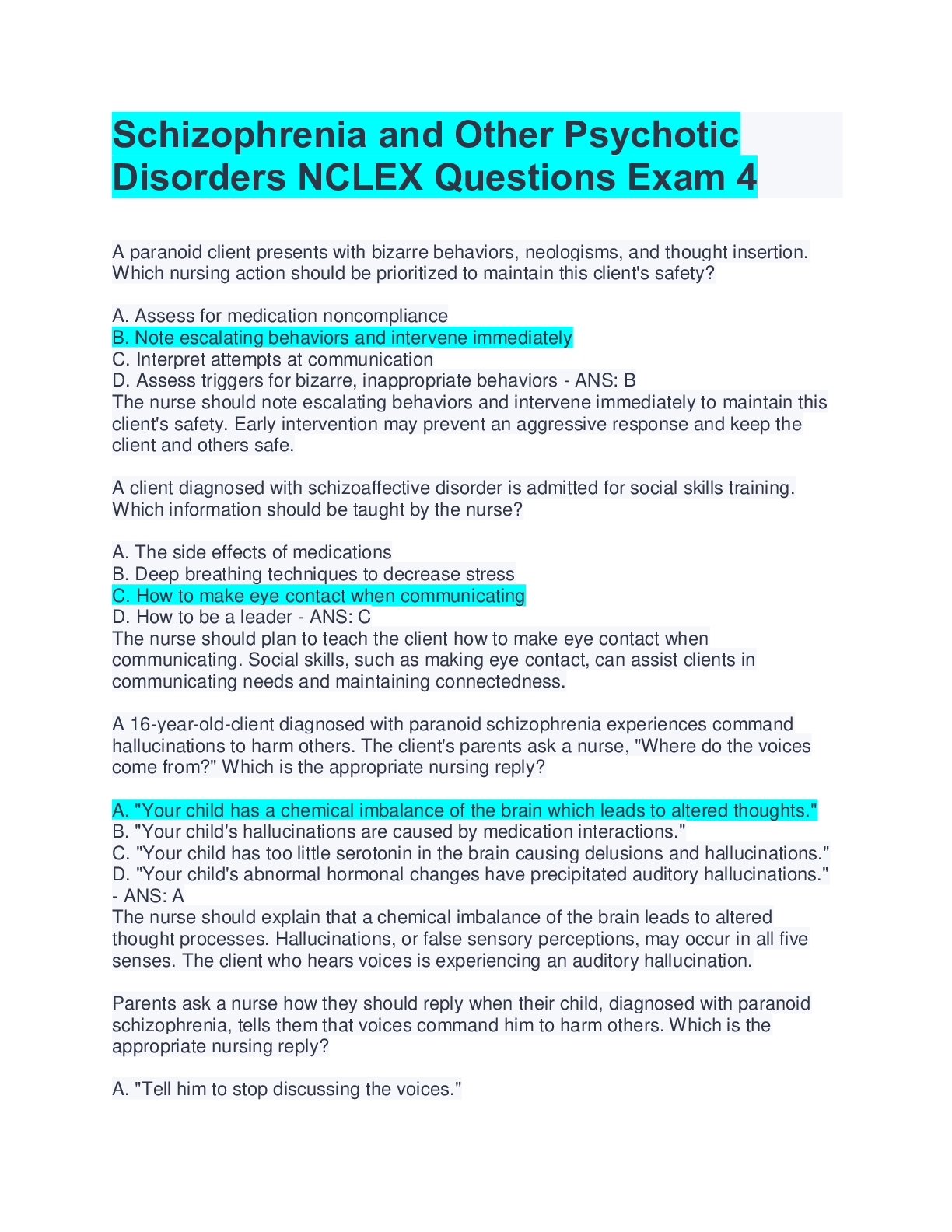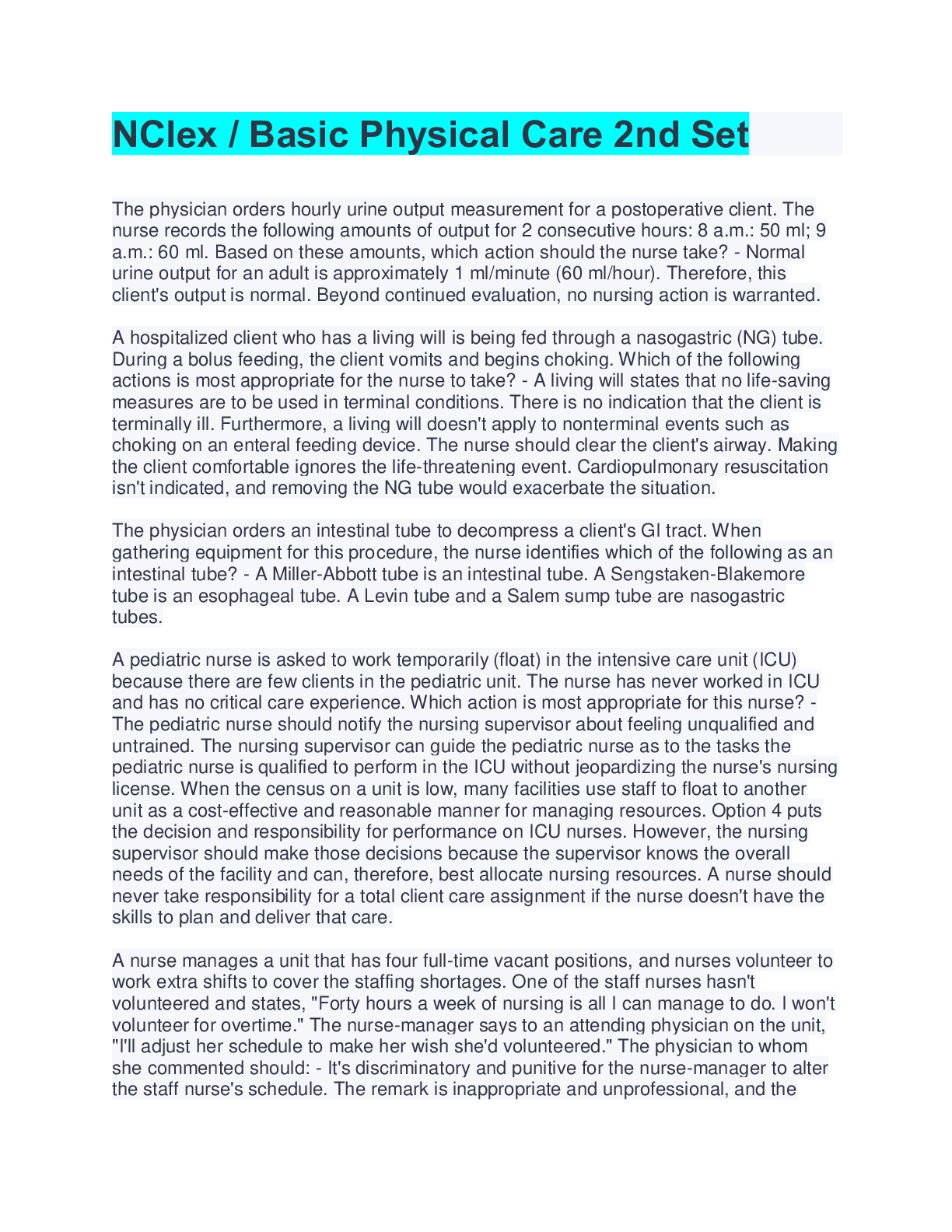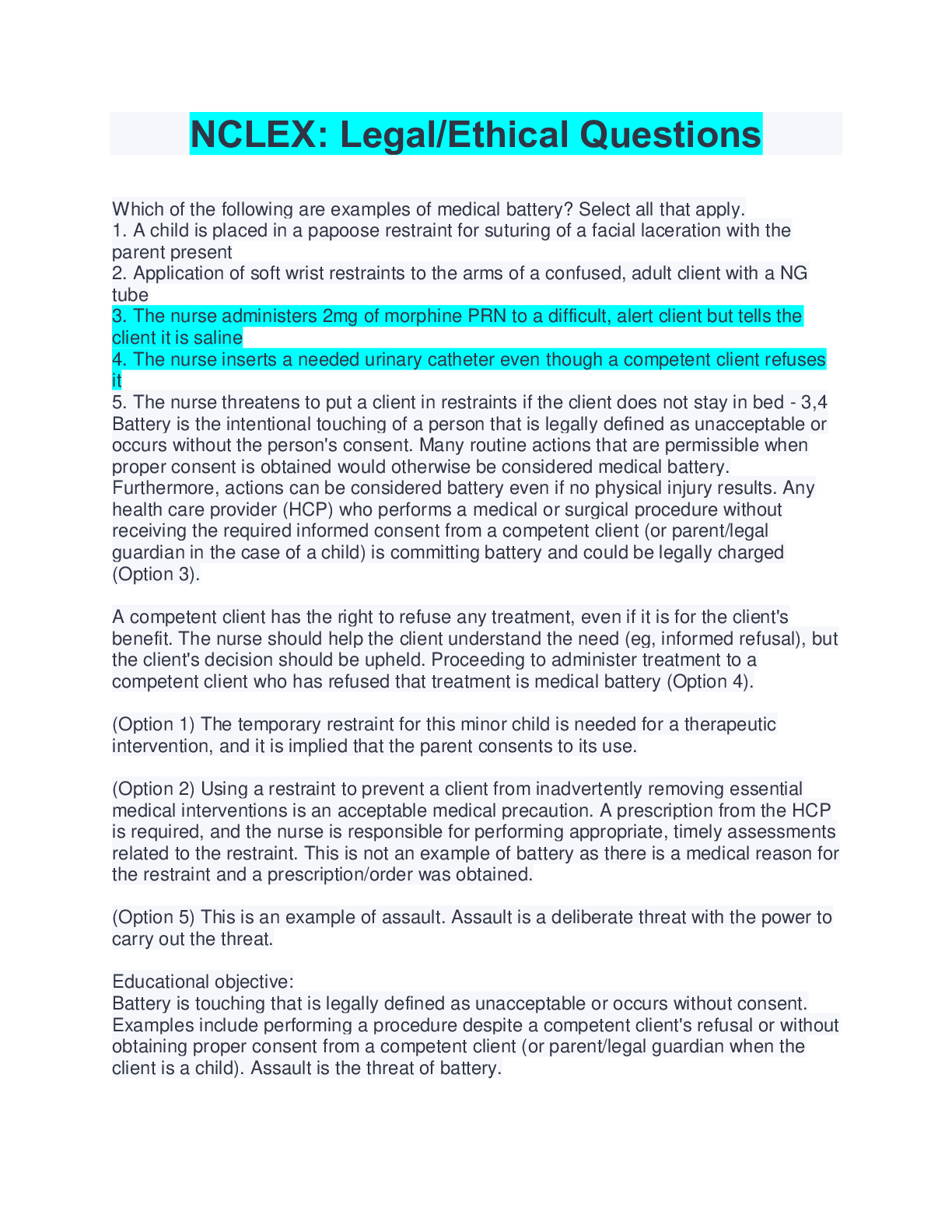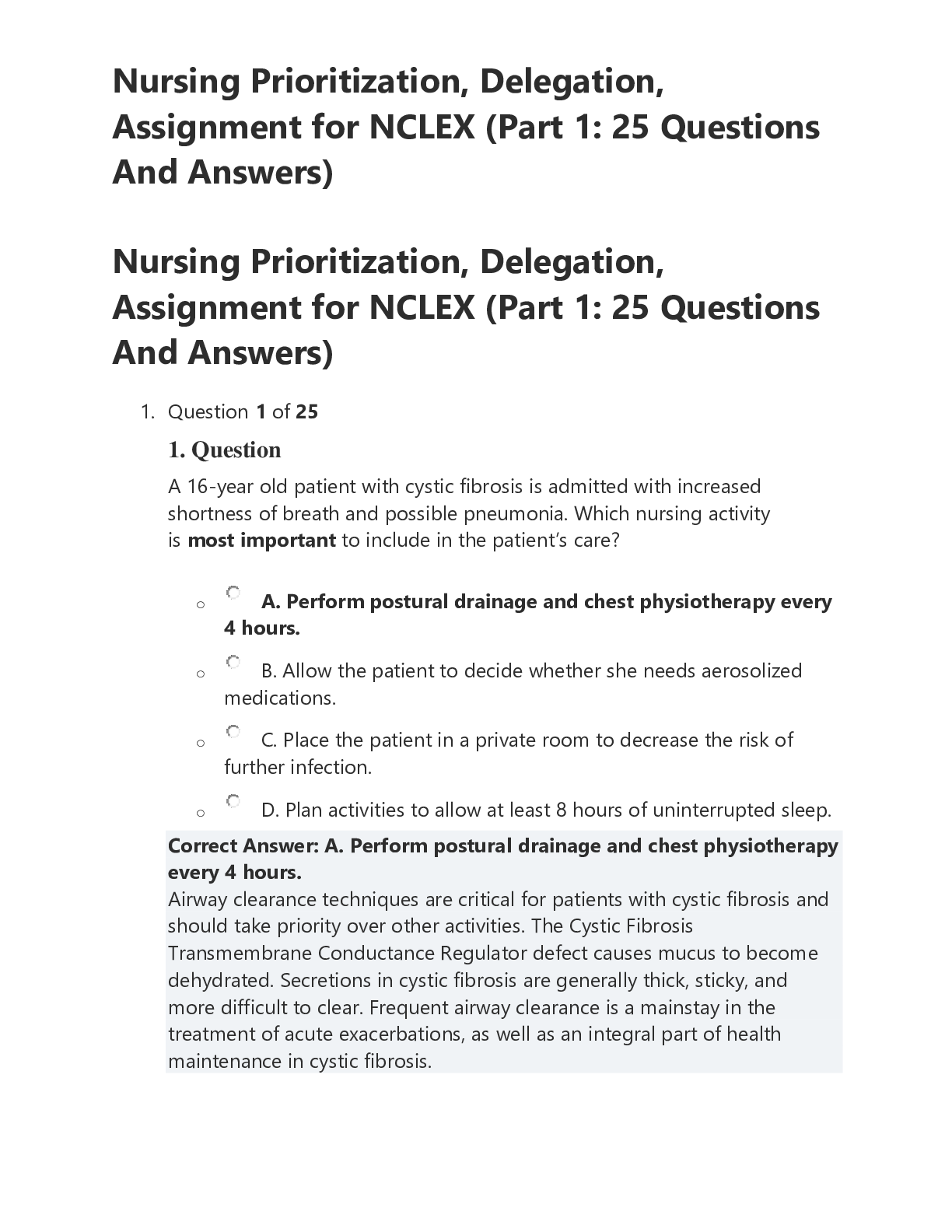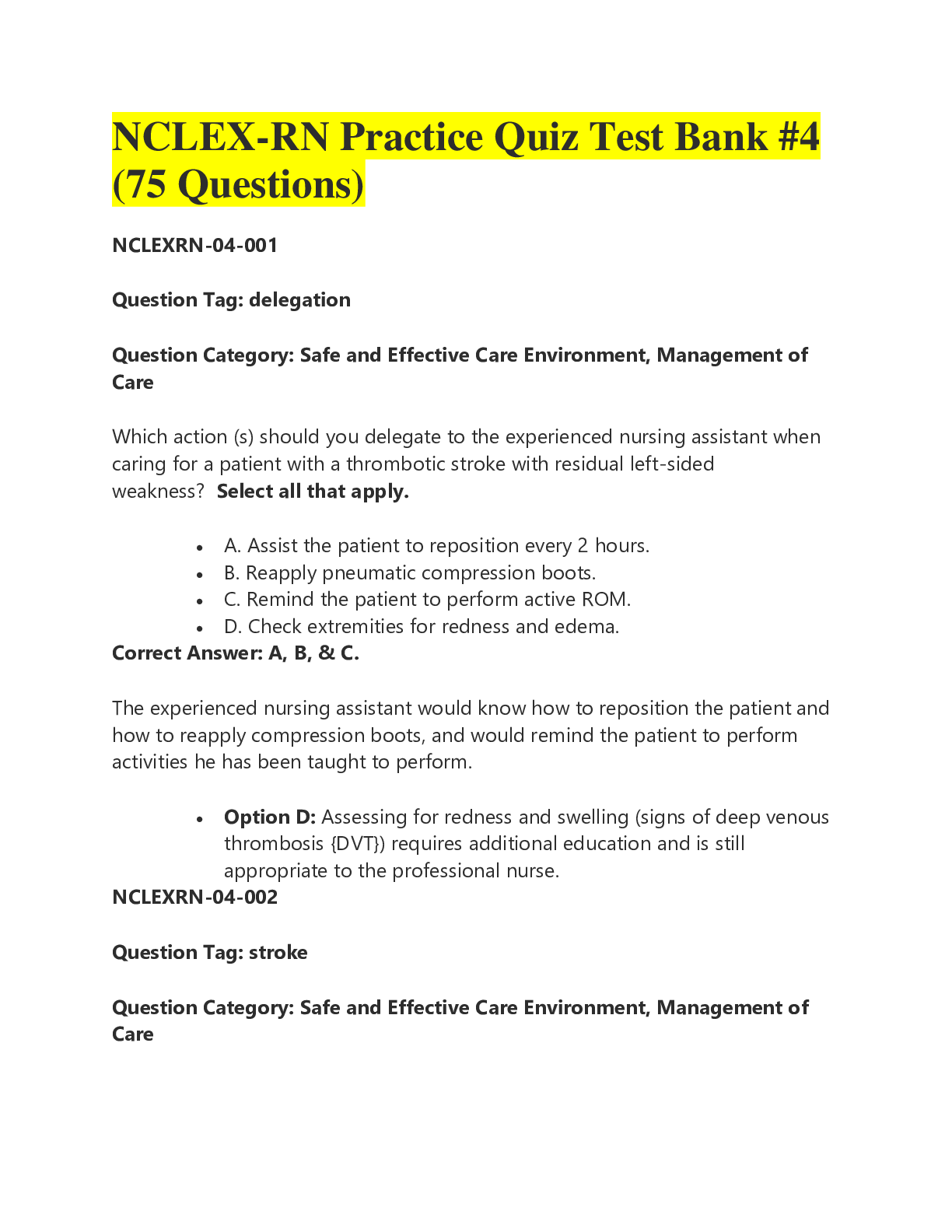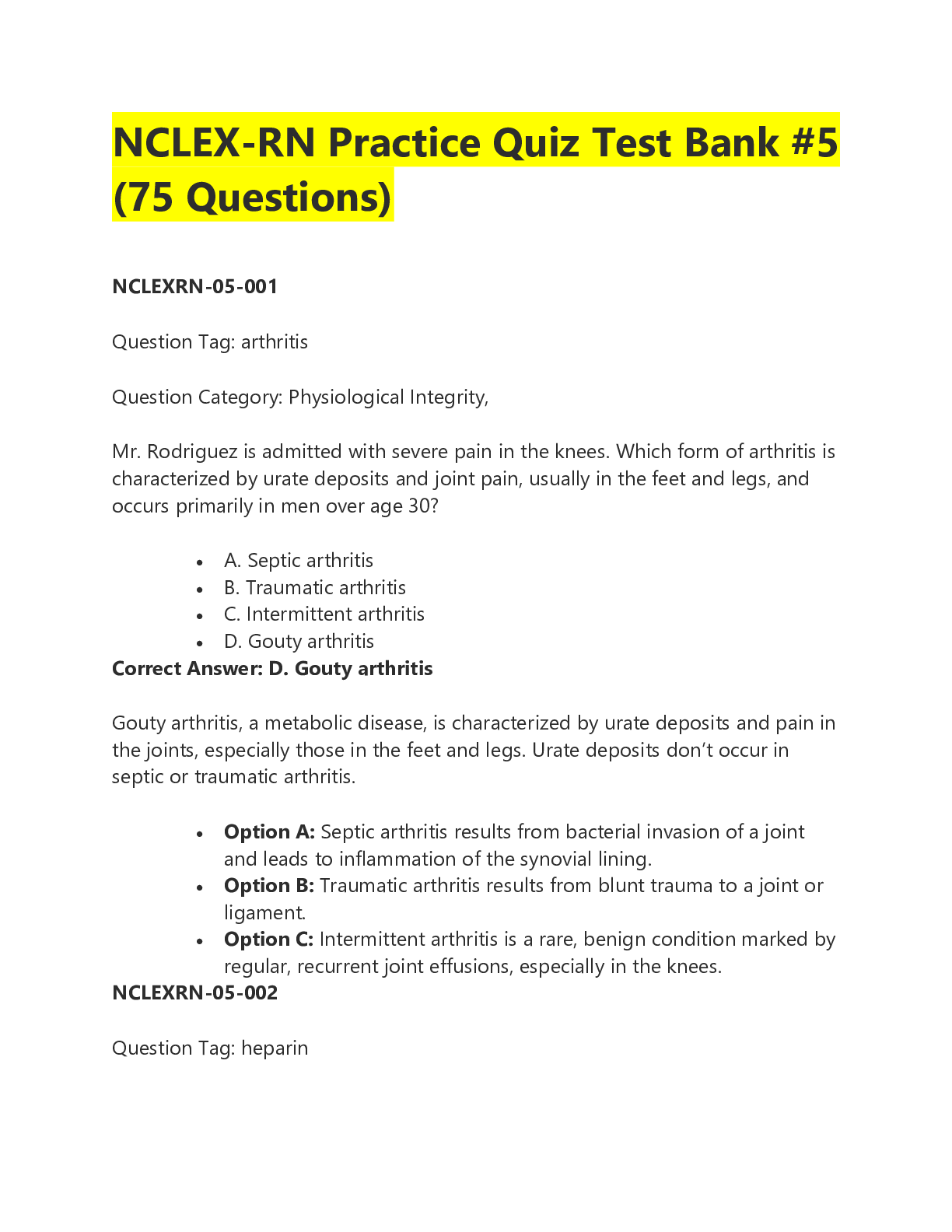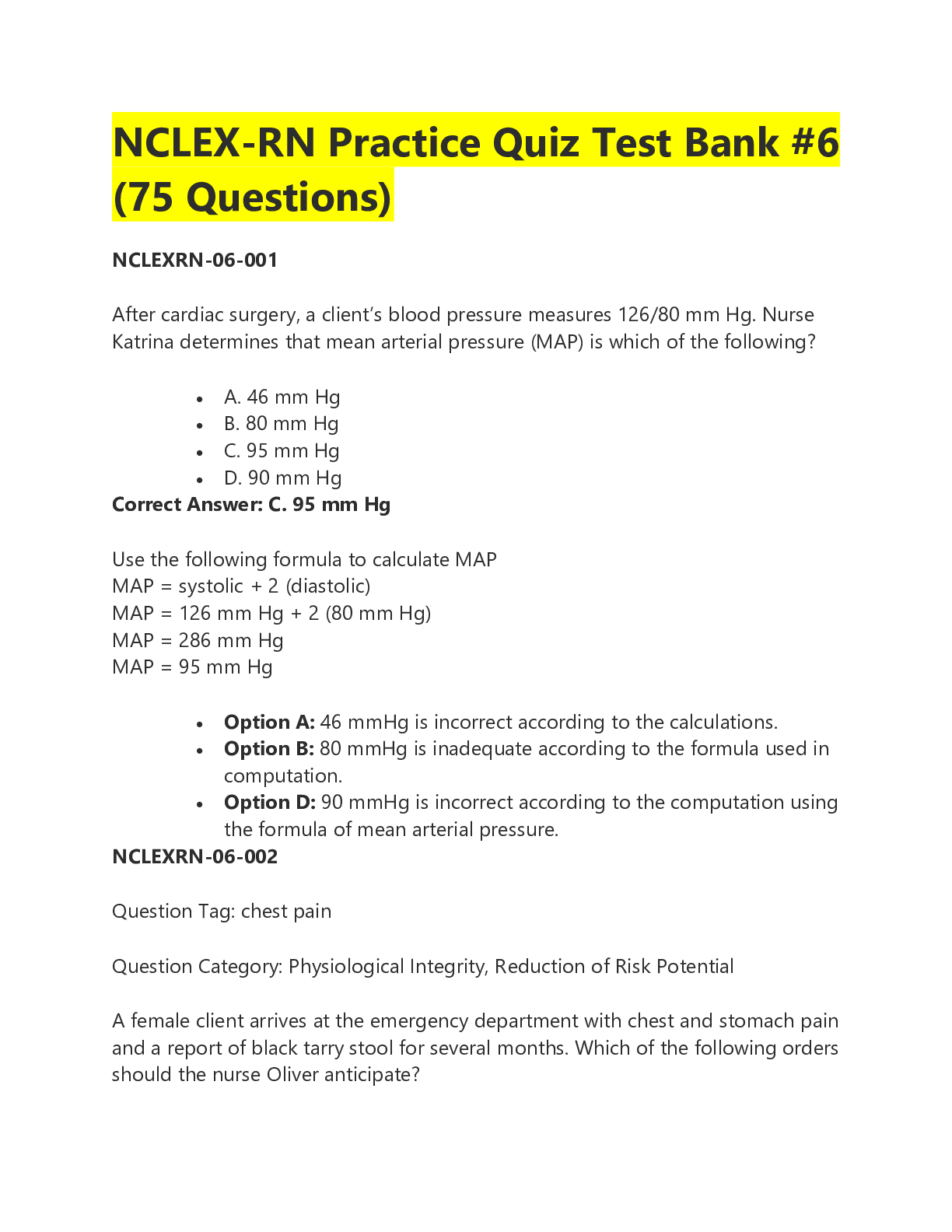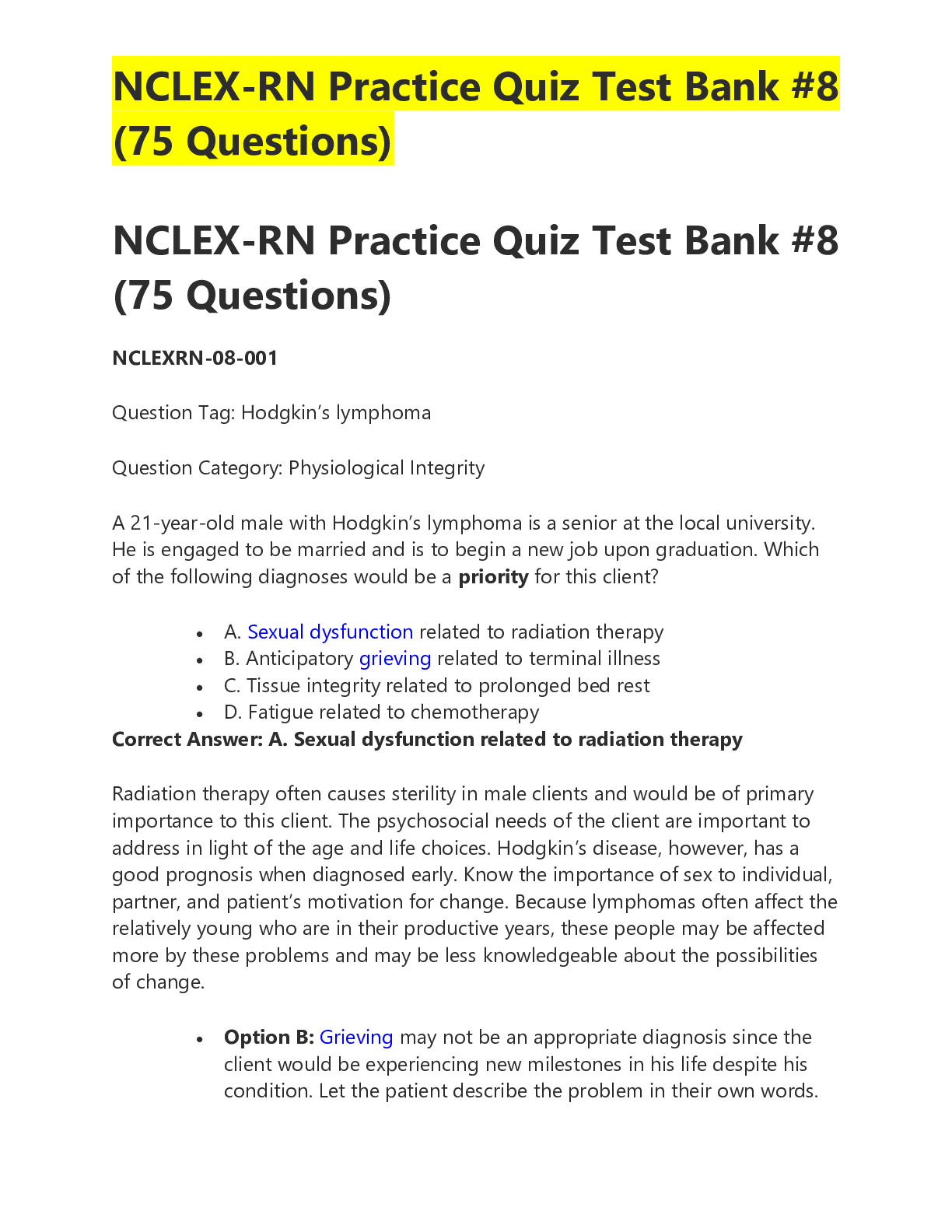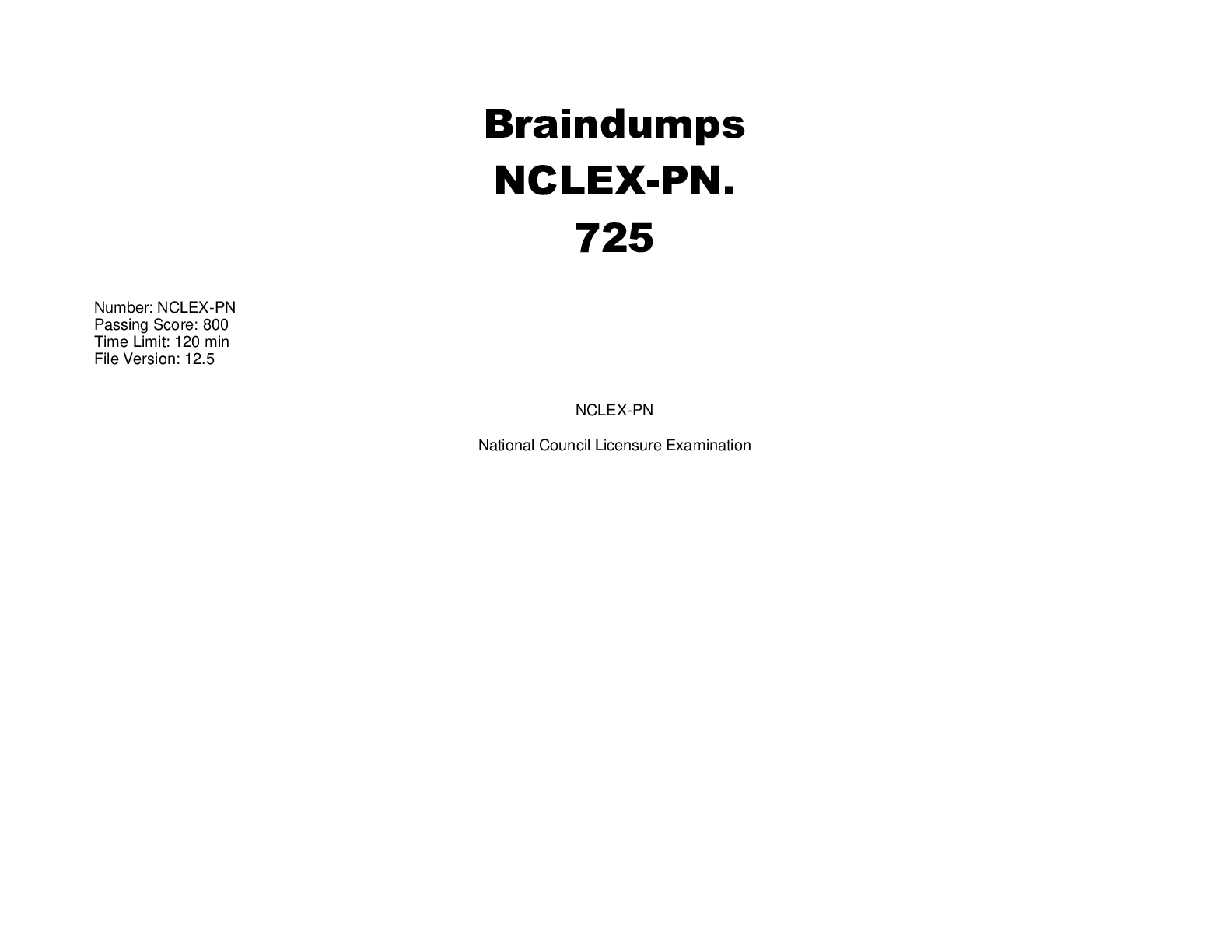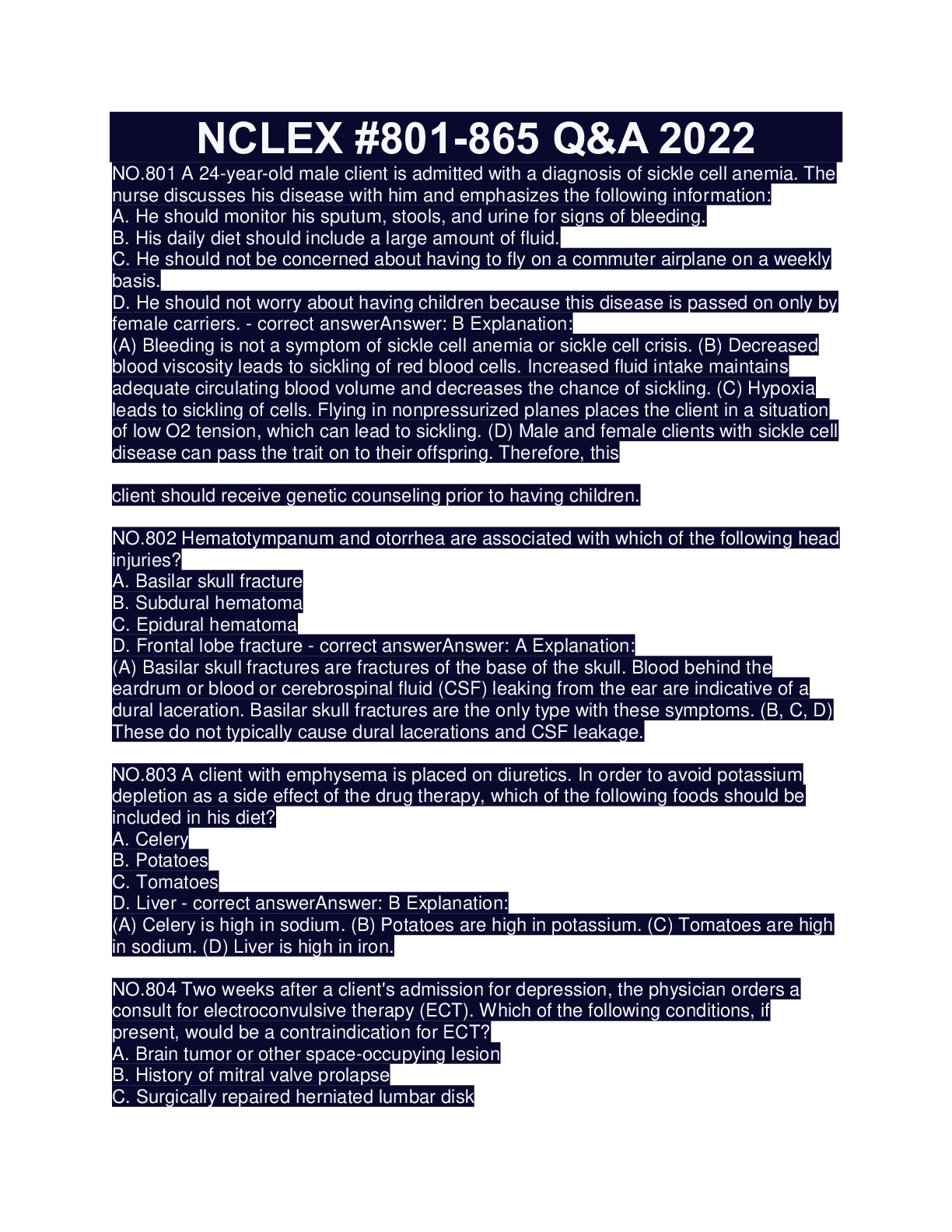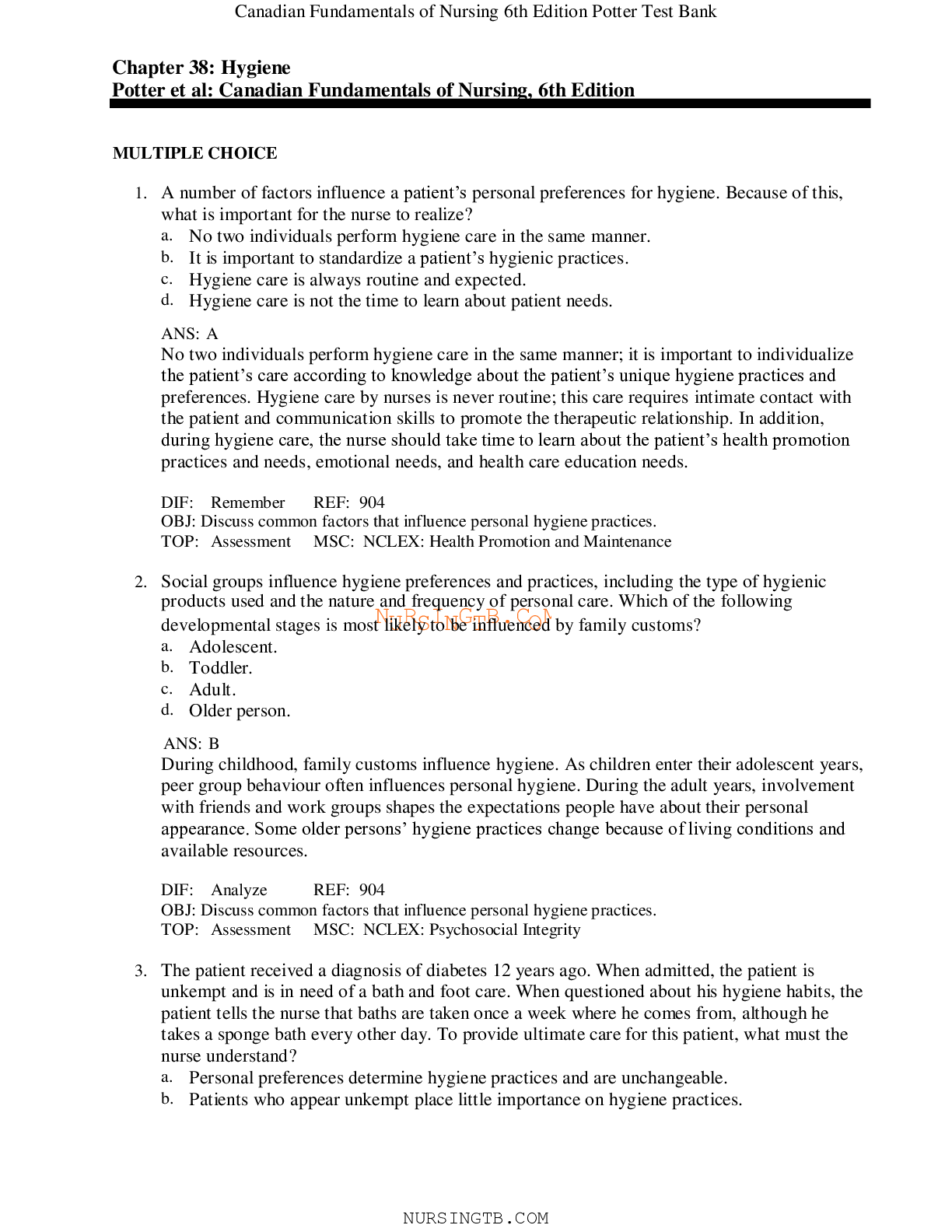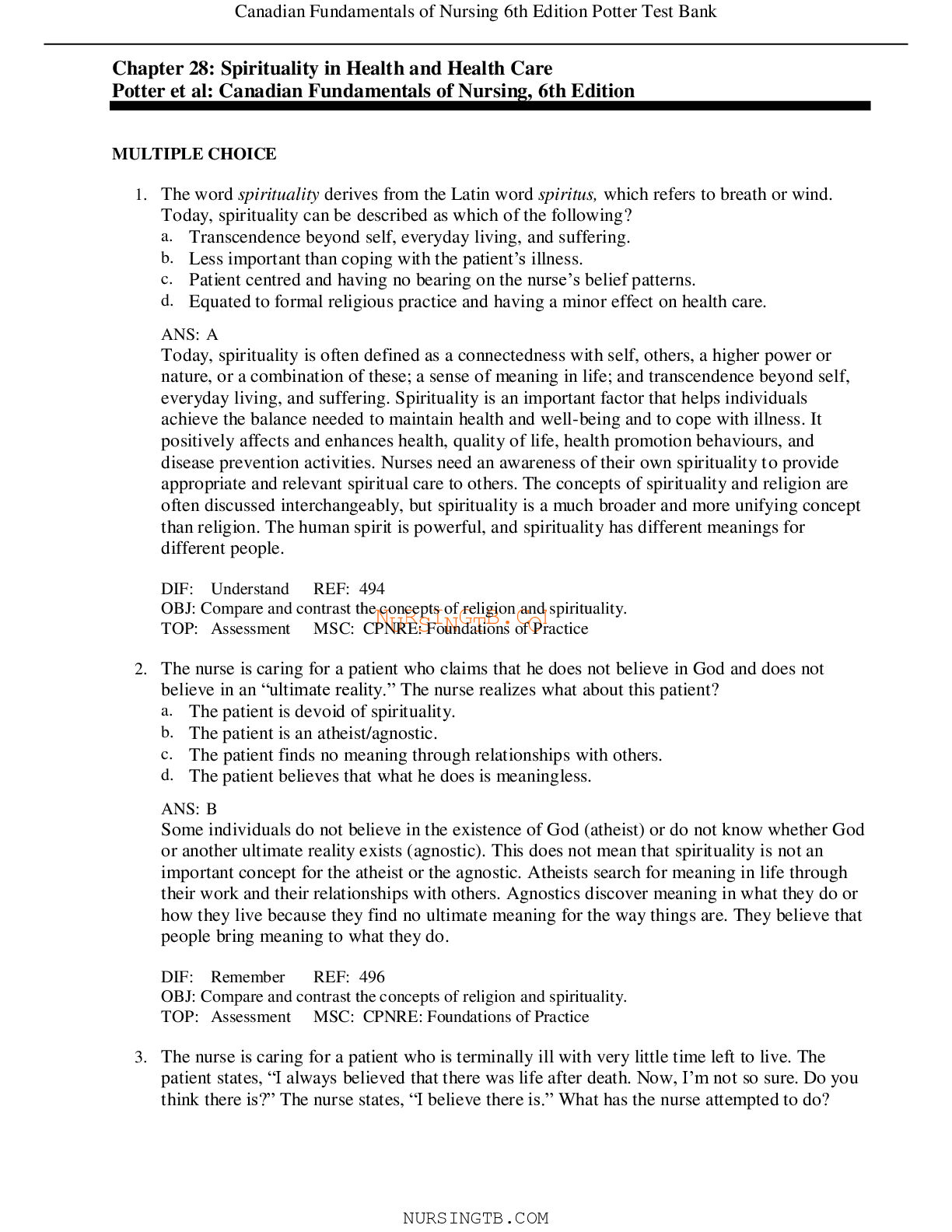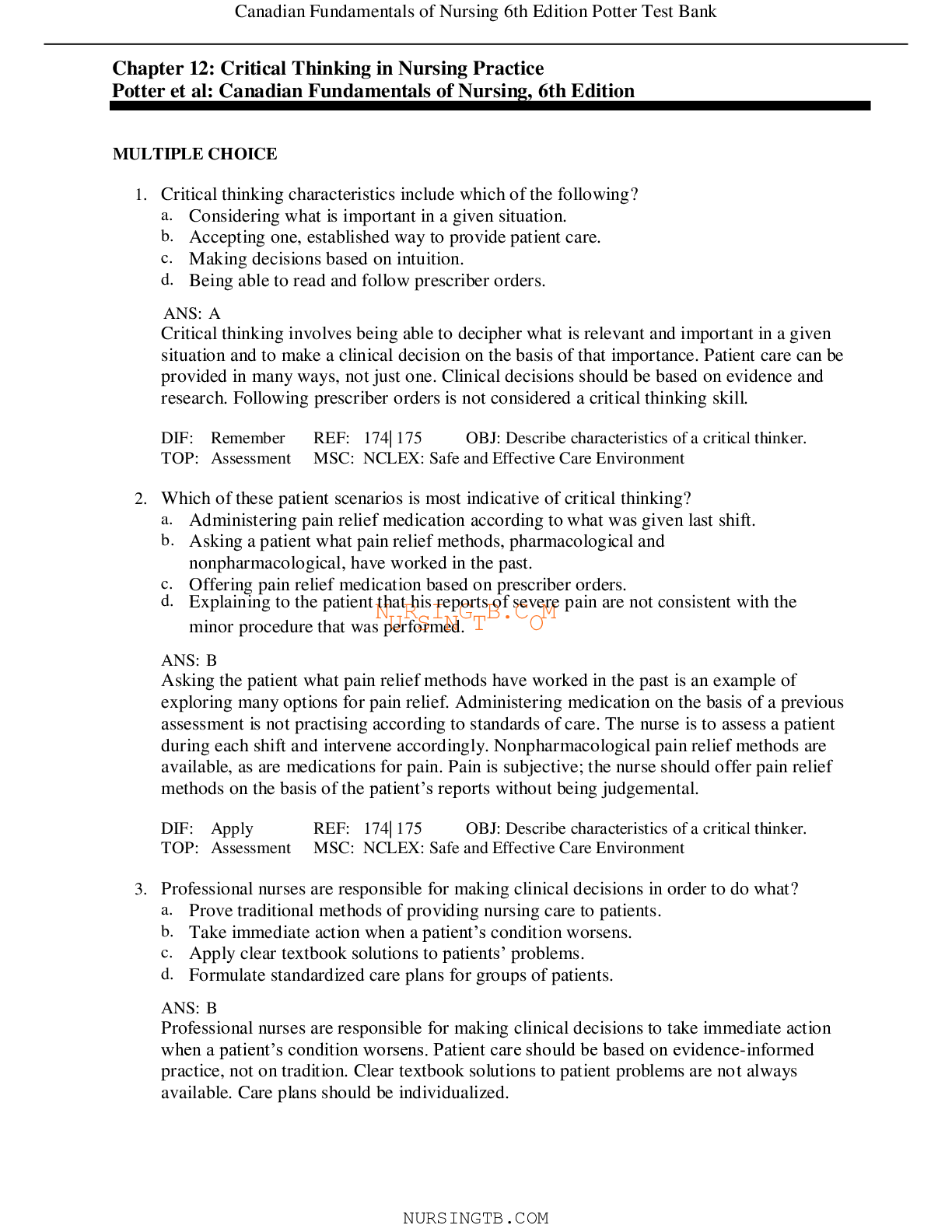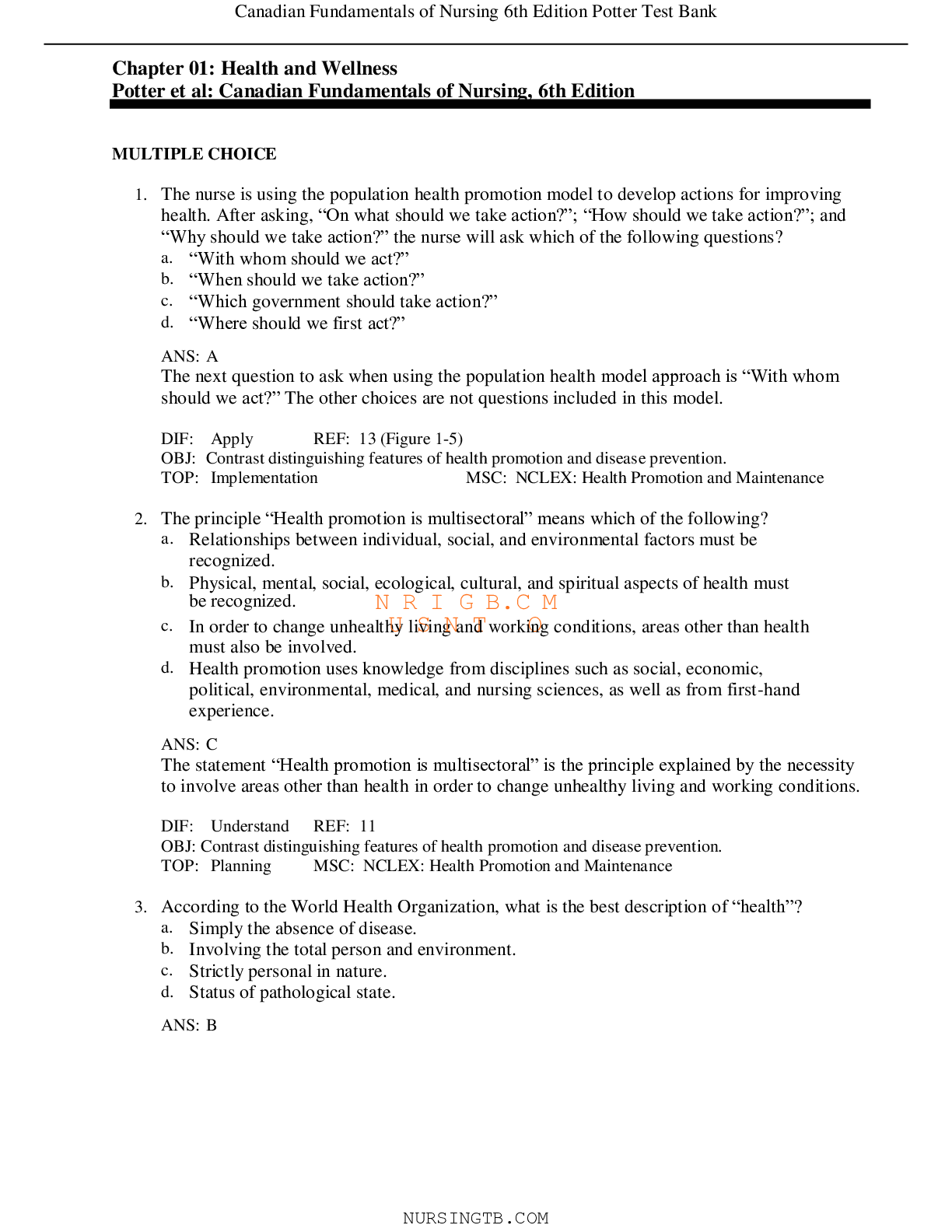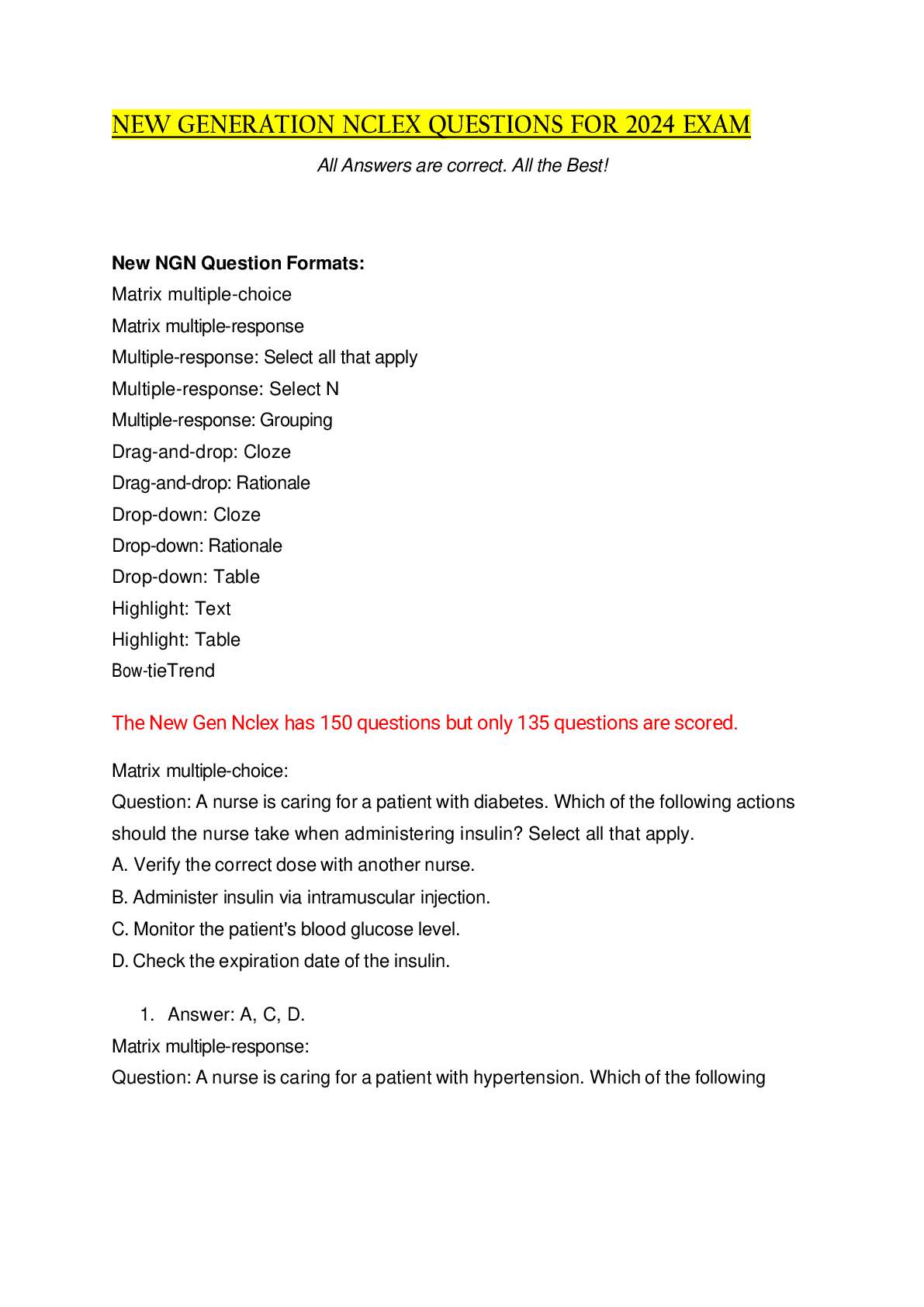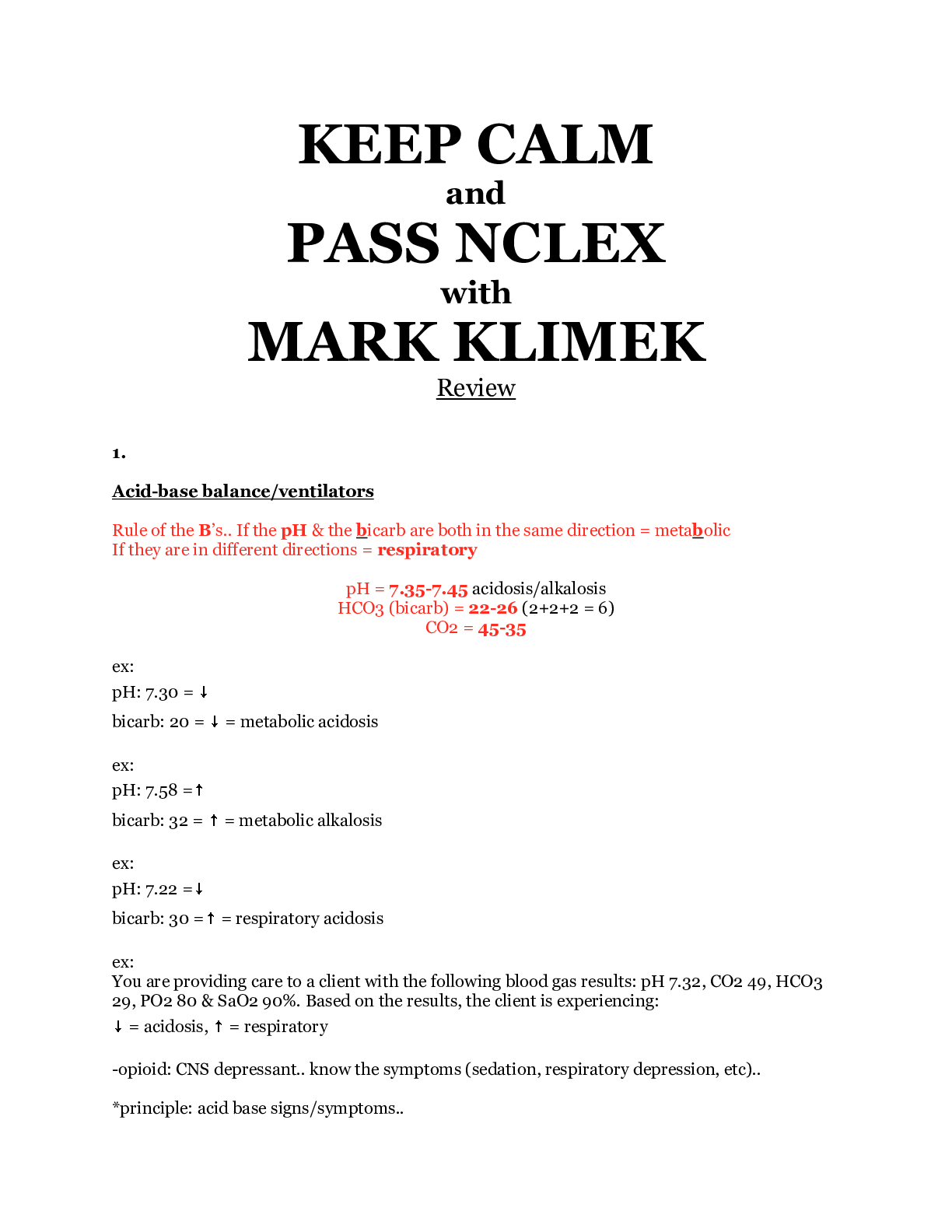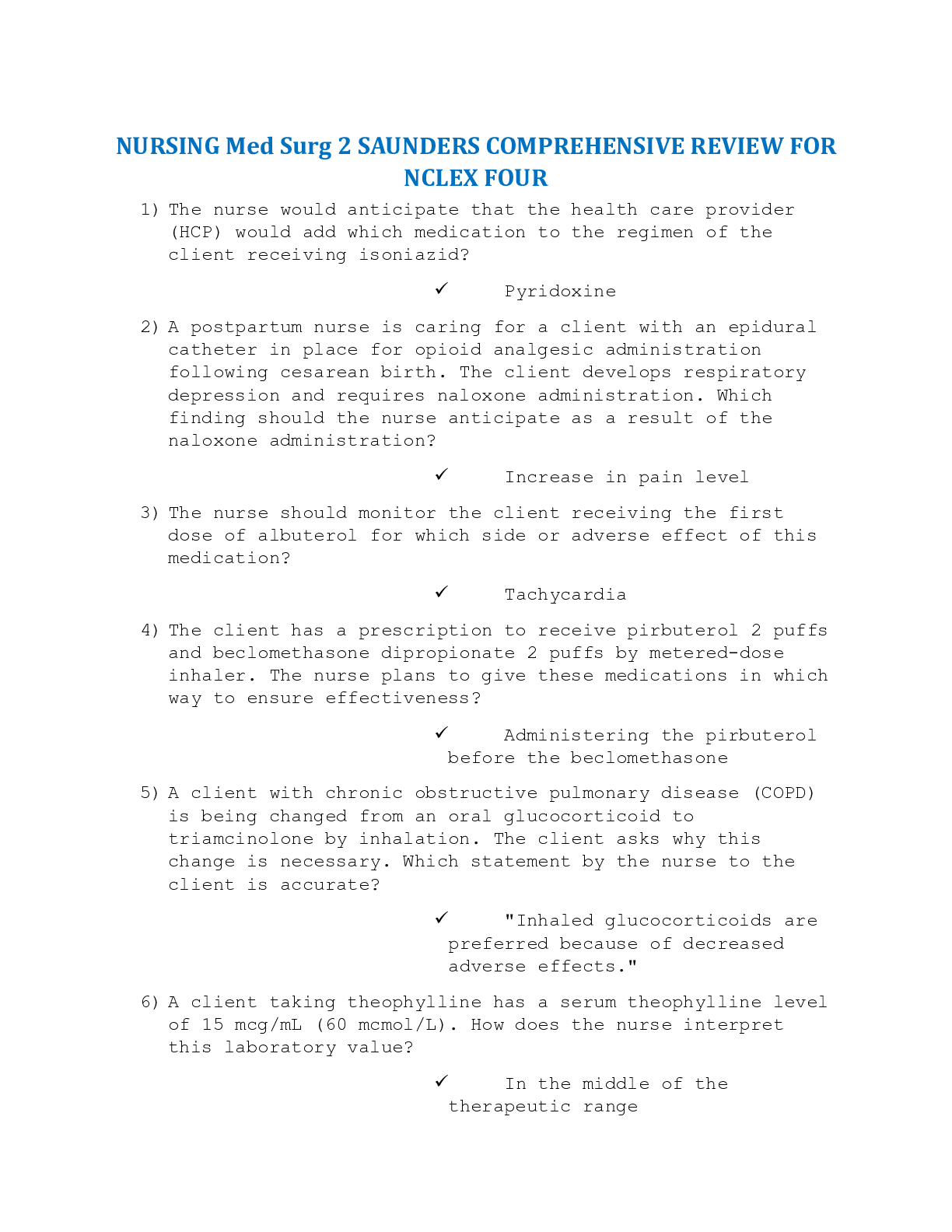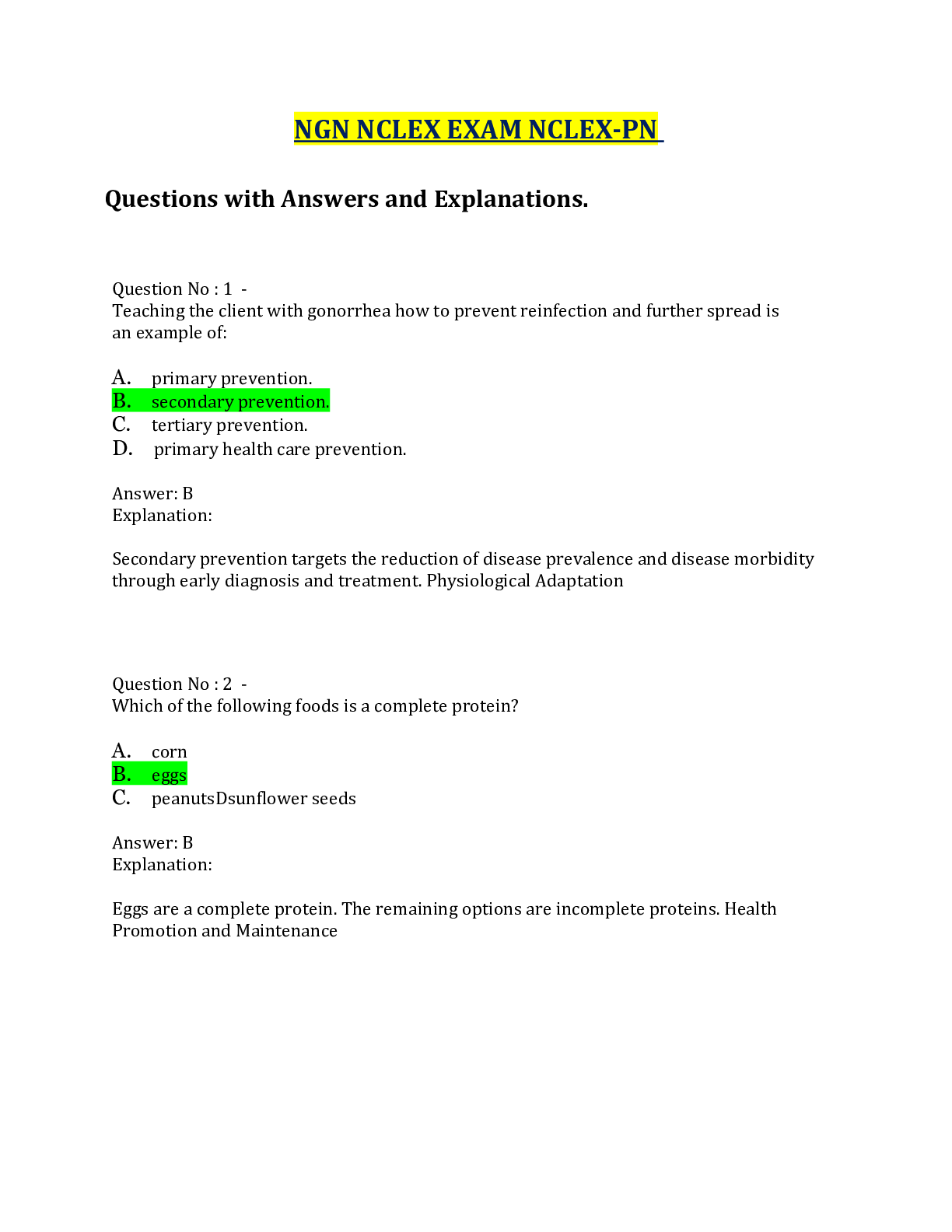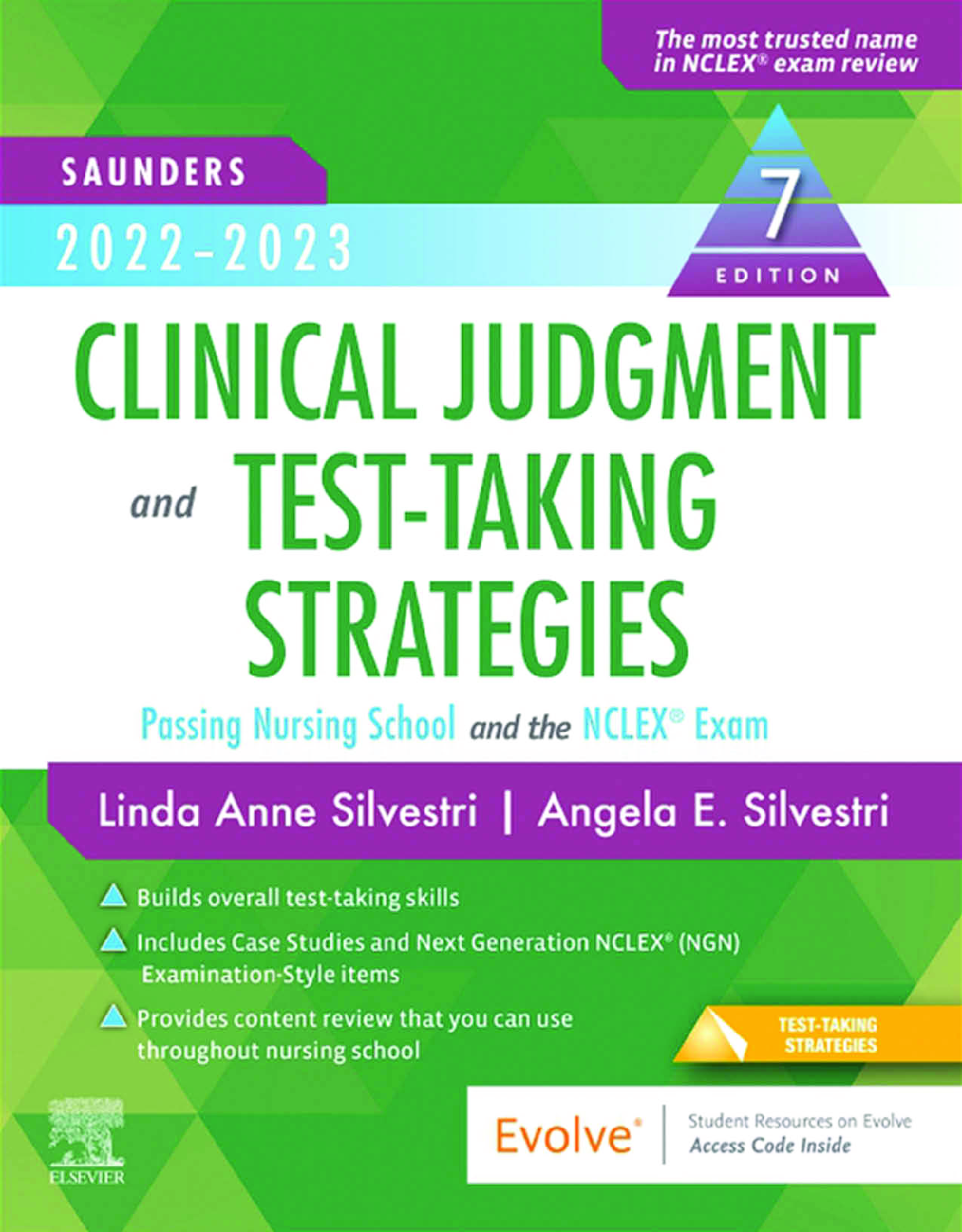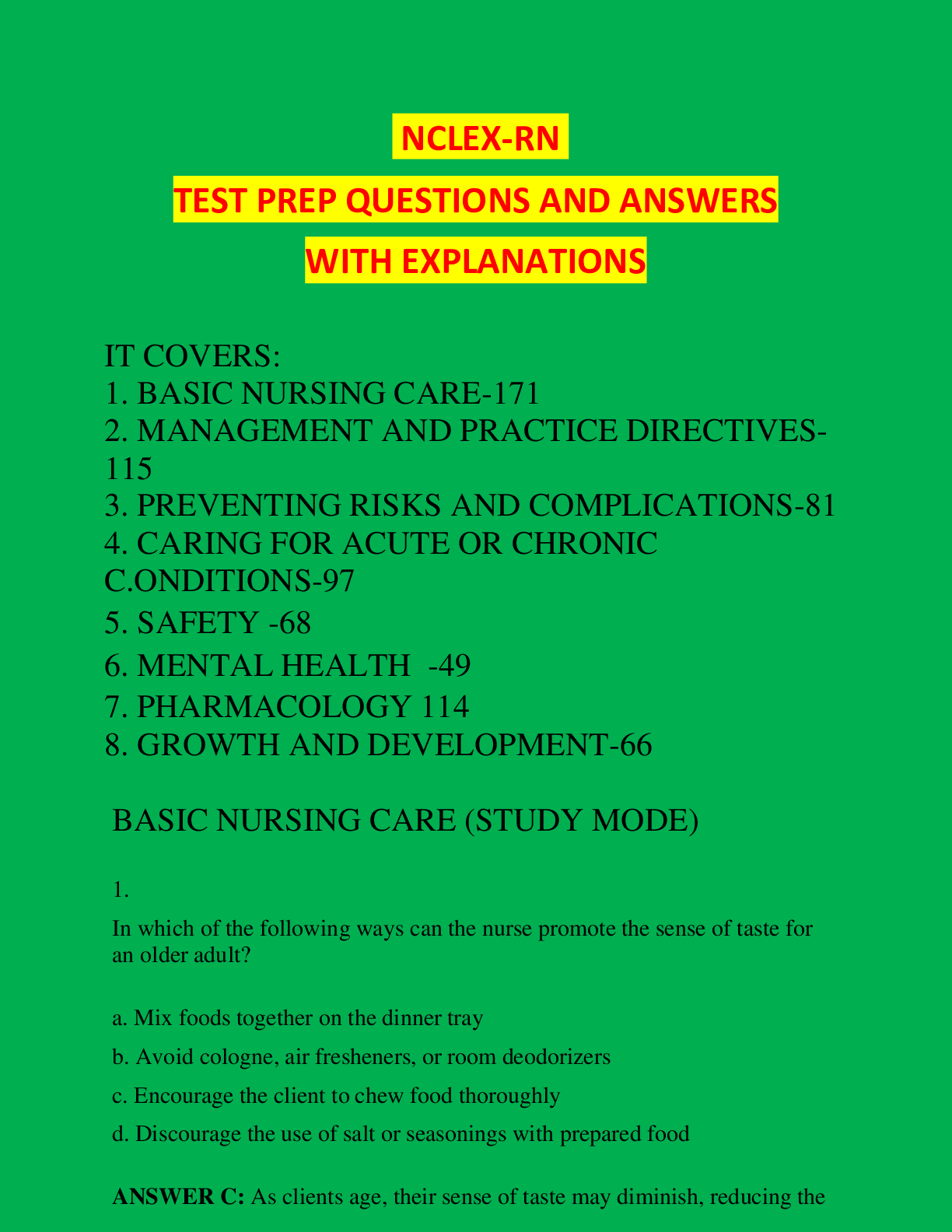*NURSING > NCLEX > Canadian Fundamentals of Nursing, 6th Edition Chapter 11: Nursing Leadership, Management, and Collab (All)
Canadian Fundamentals of Nursing, 6th Edition Chapter 11: Nursing Leadership, Management, and Collaborative Practice Potter et al:
Document Content and Description Below
Chapter 11: Nursing Leadership, Management, and Collaborative Practice Potter et al: Canadian Fundamentals of Nursing, 6th Edition MULTIPLE CHOICE 1. Which of the following is a requirement f... or a new nurse in delegating tasks to an unregulated care provider (UCP)? 2. To be able to meet the needs of assigned patients and the responsibilities associated with the position, nurses must be awaNre oRf timIe mGanaBg.emCenMt techniques. A time management skill for the nurse is which of the followUingS? N T O 3. Nursing management in a facility is considering a nursing care delivery model that involves the division of tasks, with each nurse assuming the responsibility for particular tasks. What is this model referred to as? 4. The medical centre has changNeUd RitsSoIvNerGalTl mBa.nCagOemMent philosophy from centralized to decentralized management. What is one advantage of a decentralized management structure over a centralized structure for the nursing units? 5. Which of the following is one of the four elements of decision making? 6. The charge nurse asks an experienced nurse to admit a critically ill patient who arrives in the emergency department. What does this action exemplify? 7. The nursing management team in a facility is investigating a nursing care delivery model that involves staff members working under the direction of an RN leader. What does this model reflect? In team nursing, an RN leads a team that is composed of other RNs, registered psychiatric nurses or licensed practical nurses, and UCPs. The team members provide direct patient care to groups of patients, under the direction of the RN team leader. Primary nursing is a model of care delivery whereby an RN assumes responsibility for a caseload of patients over time. Typically, the RN selects the patients for his or her caseload and cares for those patients during their hospitalization or stay in the health care setting. Functional nursing is task focused, not patient focused; in a functional nursing model, tasks are divided, with each nurse assuming responsibility for specific tasks. In a total patient care model, an RN is responsible for all aspects of care for one or more patients. The RN may delegate aspects of care but retains accountability for care of all assigned patients. DIF: Understand REF: 162 OBJ: Describe the relationships between nursing leadership and healthy practice environments, patient safety, and quality patient care outcomes. TOP: Implementation MSC: NCLEX: Safe and Effective Care Environment 8. Accountability is a critical aspect of nursing care. Which of the following is an example of a specific decision-making process of accountability? a. Selecting the medication schedule for the patient. b. Implementing discharge teaching plans that meet individual patients’ needs. c. Evaluating the patient’s outcomes after implementation of care. d. Promoting participation of all staff members in unit meetings. ANS: C Accountability refers to being answerable for actions. It involves follow-up and a reflective analysis of a nurse’s decisions to evaluate their effectiveness. Selecting the medication schedule for the patient is an example of taking responsibility. Implementing discharge teaching plans that meet indiviUduaSl patNientTs’ needOs is an example of autonomy. Promoting participation of all staff members in unit meetings is an example both of decentralized management and of promoting authority. DIF: Understand REF: 165 OBJ: Describe entry-level professional nurse competencies related to leadership, management, and collaborative practice. TOP: Evaluate MSC: NCLEX: Safe and Effective Care Environment 9. The student nurse is seeking to learn skills associated with priority setting. Among the different priorities of care, which of the following is an example of an intermediate priority? a. An obstructed airway. b. The need to urinate. c. Loss of consciousness. d. Activities of daily living in the home environment. ANS: B The need to urinate is an intermediate priority because it is a nonemergency, non–life-threatening actual or potential need. An obstructed airway is of high priority because it is an immediate threat to a patient’s survival or safety. Loss of consciousness is of high priority because it is an immediate threat to a patient’s survival or safety. Activities of daily living in the home environment are a fourth-order priority; they represent an actual or potential problem with which the patient or family members may need help in the future. DIF: Apply REF: 166 OBJ: Discuss ways to apply skills of clinical care coordination in nursing practice. TOP: Assessment MSC: NCLEX: Safe and Effective Care Environment 10. The nurse on the unit is determining which activities may be delegated to an unregulated care provider (UCP). A number of factors are included in the nurse’s decision. Assuming that the UCP is competent, the RN may safely delegate which of the following activities? a. Ambulation of stable patients. b. Documenting an admission history for a new patient. c. Performance of the initial transfer of a postoperative patient. d. Administering medications prepared by the RN. ANS: A An institution’s policies and procedures and job description for a UCP provide specific guidelines with regard to which tasks or activities can be delegated. The nurse should match tasks to the delegate’s skills, such as ambulating stable patients. An admission history for a new patient should not be prepared by a UCP; the RN should perform this task. The initial transfer of a postoperative patient should not be delegated to a UCP, as the patient would be considered unstable; the RN should perform this task. The nurse should not delegate medication administration to anyone, if the nurse prepared it; the UCP is not licensed to administer medication. DIF: Apply REF: 166| 167 OBJ: Discuss principles for the appropriate delegation of patient care activities. TOP: Implementation MSC: NCLEX: Safe and Effective Care Environment 11. UCPs are allowed to perform tasks with patients in which situation? a. When tasks are delegatedNbUyRanSoIthNerGUTCBP.. COM b. When asked by the patient. c. With another UCP. d. When tasks are delegated by an RN. ANS: D An institution’s policies, procedures, and job descriptions for UCPs provide specific guidelines regarding which tasks or activities can be delegated. UCPs are not allowed to perform actions authorized for RNs unless these tasks have been properly delegated by an RN, and they can perform such actions only if they are within the UCP’s job description and employer policy. It is not appropriate to perform tasks that are delegated by another UCP, when asked by the patient, or with another UCP. DIF: Understand REF: 166| 167 OBJ: Discuss principles for the appropriate delegation of patient care activities. TOP: Implementation MSC: NCLEX: Safe and Effective Care Environment 12. One type of nursing model is an emerging model among intraprofessional nursing teams and other health care providers who are members of the interprofessional team. What is this model called? a. Primary nursing model. b. Functional nursing model. c. Team nursing model. d. Collaborative practice model. ANS: D The Registered Nurses Association of Ontario (2016) has developed evidence-informed Best Practice Guidelines for collaborative practice among nurses, interprofessional health teams, and health professionals. The other models are not considered emerging models: The primary nursing model was popular in the 1970s and 1980s; the functional nursing model was popular during World War II in response to a nursing shortage; and the team nursing model was developed in response to a nursing shortage after World War II. DIF: Understand REF: 162| 163 OBJ: Discuss how a nurse leader can contribute to collaborative practice and best practices implementation. TOP: Implementation MSC: NCLEX: Safe and Effective Care Environment 13. A management structure in which traditional units are reorganized into business units is called what? a. Matrix. b. Centralized. c. Decentralized. d. Participatory. ANS: A In a matrix management structure, traditional units are reorganized into business units. Staff may report to several managers who may be from a variety of professional practice backgrounds. Traditional units are not reorganized into business units in centralized, decentralized, or participatory management structures. DIF: Understand REF: 164 (Table 11-1) OBJ: Discuss how a nurse leaNder cRan cIontrGibutBe .toCcollMaborative practice and best practices implementation. TOP: Implementation MSC: NCLEX: Safe and Effective Care Environment 14. Which term characterizes the duties and activities that an individual is employed to perform? a. Autonomy. b. Authority. c. Responsibility. d. Accountability. ANS: C The duties and activities that an individual is employed to perform reflect responsibility. Autonomy is the freedom of choice and responsibility for choices. Authority is the right to act in areas in which a nurse has been given and accepts responsibility according to legislation, standards, and the code of ethics. Accountability refers to being answerable for one’s actions. DIF: Understand REF: 164| 165 OBJ: Describe entry-level professional nurse competencies related to leadership, management, and collaborative practice. TOP: Implementation MSC: NCLEX: Safe and Effective Care Environment 15. What is a nursing manager’s greatest challenge? a. Delegation. b. Communication. c. Time management. d. Clinical decision making. ANS: B Communication with staff is one of the nursing manager’s greatest challenges, especially in a large work group in which change is constant. The nursing manager’s greatest challenge is not delegation, time management, or clinical decision making. DIF: Understand REF: 165 OBJ: Discuss how a nurse leader can contribute to collaborative practice and best practices implementation. TOP: Planning MSC: NCLEX: Safe and Effective Care Environment MULTIPLE RESPONSE 1. Creating a culture of patient safety includes which of the following? (Select all that apply.) a. Awareness of health care error. b. Ensuring feedback on safety issues. c. Commitment to a just, punitive environment. d. Promotion of a systems approach to care. e. Reporting of adverse events. ANS: A, B, D, E Awareness of health care error, ensuring feedback on safety issues, promotion of a systems approach to care, and reporting of adverse events are characteristics of a culture of patient safety. Commitment to a just, nonpunitive (rather than punitive) culture is advocated in this culture. DIF: Understand REF: 168 OBJ: Describe the purpose, elNemUeRntSs, IanNd GmTodBel.s CfoOr qMuality practice environments and patient safety. TOP: Planning MSC: NCLEX: Safe and Effective Care Environment 2. A nurse has delegated a task to an unregulated care provider (UCP). Which of the following is the nurse responsible for? (Select all that apply.) a. Performing the task safely. b. Maintaining accountability of the task. c. Ensuring the task is within the UCP’s job description. d. Supervising the UCP if required. e. Providing clear instructions when delegating a task. ANS: B, C, D, E When delegating a task to a UCP, the nurse is responsible for maintaining accountability for the task, ensuring that the task is within the UCP’s job description, supervising the UCP if required by policy, and providing clear instructions about the task. The UCP is responsible for performing the task safely. DIF: Understand REF: 166 OBJ: Discuss principles for the appropriate delegation of patient care activities. TOP: Planning MSC: NCLEX: Safe and Effective Care Environment [Show More]
Last updated: 1 year ago
Preview 1 out of 7 pages

Reviews( 0 )
Document information
Connected school, study & course
About the document
Uploaded On
Aug 08, 2021
Number of pages
7
Written in
Additional information
This document has been written for:
Uploaded
Aug 08, 2021
Downloads
0
Views
49


